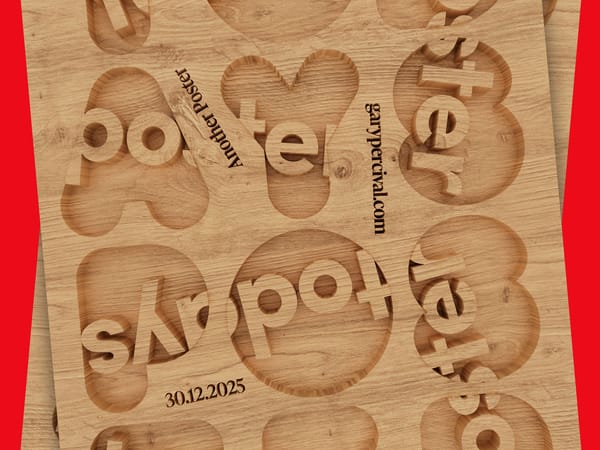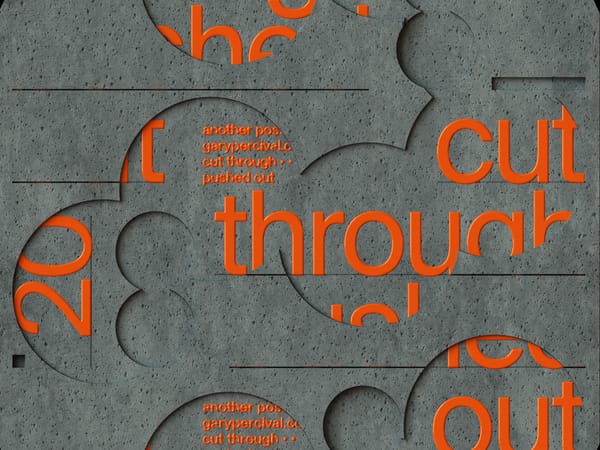Beyond Social Media: Innovative Ways to Reach Your Audience
Social media platforms have become indispensable tools in the marketing toolkit for independent creative professionals, graphic designers, and artists seeking to establish their personal brand.


Social media platforms have become indispensable tools in the marketing toolkit for independent creative professionals, graphic designers, and artists seeking to establish their personal brand.
With billions of users active on platforms like Instagram, Twitter, LinkedIn, and Facebook, social media offers an incredible opportunity to connect with and engage your audience. But is that enough?
While social media certainly wields immense power, it shouldn't be the be-all and end-all of your marketing efforts. Solely relying on it can limit your reach and leave potential business opportunities untapped. Remember, not everyone uses social media, and even those who do may not actively seek out or engage with your brand on these platforms.
That's why diversifying your marketing strategies is essential, as is exploring innovative ways to connect with your audience beyond the confines of social media. From traditional tactics like email marketing to modern approaches like influencer partnerships, there's a whole world of possibilities waiting for you.
This post aims to illuminate some of these alternative strategies, helping you expand your horizons and effectively reach your target audience where they're most receptive.
The Limitations of Social Media
Social media, while a valuable tool, comes with its own set of limitations.
Recognising these can help you strategise effectively and understand the importance of exploring different ways to reach your audience.
- Algorithm Changes: Social media platforms often tweak their algorithms, affecting how your content is seen by followers. These changes can impact your visibility and engagement, making it harder for your creative work to be discovered.
- Content Overload: The social media space is crowded, with countless posts shared every day. It's easy for your unique designs or creative content to get lost in the shuffle.
- Limited Control: When you rely on social media platforms, you're essentially renting space. Your control over your presence is limited, and you're at the mercy of the platform's rules and policies.
- Demographic Limitations: While many demographics use social media, some are more active than others. If you rely solely on social media, you might miss reaching potential clients in different age groups or geographic locations.
- Trust Issues: Due to recent concerns about data and privacy, some users are cutting back on social media or leaving platforms altogether. This could mean missed opportunities for freelancers and creatives.
Acknowledging these challenges doesn't mean you should abandon social media. Instead, it highlights the need to diversify your approach. By finding innovative ways beyond social media to connect with your audience, you can navigate around these issues, expand your reach, and create more opportunities to engage with potential clients.
Whether it's email marketing that allows direct communication with your audience, content marketing that showcases your expertise, or influencer partnerships that boost your visibility, there are numerous avenues to explore. By doing so, you can build a more resilient, adaptable, and effective strategy to promote your creative work.

Email Marketing
Email marketing, at its core, involves using email to promote your creative services.
But it's more than just sending a bunch of emails to a list. It's about building connections with potential clients and ensuring your work stays fresh in their minds.
How does it work? You start by growing an email list of people who have shown interest in your work. This could be through a sign-up form on your portfolio website, at a networking event, or even through direct interactions. Once you have a list, you can send them regular updates about your latest projects, special offers, relevant content, and more.
So why should freelancers and creatives consider email marketing?
Here are a few benefits:
- Direct Communication: Unlike social media, where your posts may get lost in the feed, emails land directly in your audience's inbox, increasing the chances of your work being seen.
- Cost-Effective: Email marketing is relatively inexpensive, making it a great option for freelancers and small studios.
- Highly Targeted: You can segment your email list based on various criteria, enabling you to tailor your message to different groups within your audience.
- Measurable: With email marketing tools, you can track open rates, click-through rates, and conversions, giving you valuable insights into how well your campaigns are working.
Ready to dive into email marketing?
Here are some tips:
- Provide Value: Whether it's a sneak peek at your latest project, a useful tutorial, or updates about your creative journey, make sure your emails provide value to your audience.
- Keep it Concise: People get a lot of emails. Keep yours short, sweet, and engaging to hold your reader's attention.
- Use a Strong Call-to-Action: Make it clear what you want your readers to do after reading your email. Whether it's checking out your updated portfolio, booking a consultation, or sharing your work, a strong call-to-action can help drive engagement.
- Test and Optimise: Experiment with different subject lines, email formats, and send times. Use your campaign data to learn what resonates with your audience and continuously improve your approach.
Remember, successful email marketing isn't about spamming your audience with sales pitches. It's about providing value, showcasing your creativity, and building relationships, one email at a time.

Content Marketing
Content marketing involves creating and sharing relevant, valuable, and consistent content to attract and engage a specific audience.
But it's not about direct selling; instead, it's about offering useful insights to your audience to build trust and position yourself as an authority in your field.
In today's digital age, where people have vast amounts of information at their fingertips, content marketing is vital. By providing valuable content, you can organically attract potential clients, guide them through the decision-making process, and even turn them into advocates for your work.
There are several types of content marketing that freelancers and creatives can explore:
- Blogs: Blogs allow you to share in-depth insights, offer useful tips, and establish yourself as a thought leader in your creative field.
- Videos: Videos are engaging and perfect for showcasing your creative process, sharing client testimonials, or offering behind-the-scenes glimpses of your work.
- Podcasts: Podcasts offer a personal way to share your knowledge, interview industry experts, and connect with your audience.
- Infographics: Infographics simplify complex information, making it more digestible and visually appealing—perfect for demonstrating design concepts.
- eBooks and White papers: These provide a platform for more comprehensive content that can showcase your extensive knowledge on a particular creative subject.
So, how can you create content that is both interesting and valuable?
Here are some tips:
- Know Your Audience: Understanding who your audience is, what they're interested in, and what challenges they face is the first step in creating great content.
- Provide Value: Whether it's teaching a new design technique, offering a unique perspective, or solving a creative problem, make sure your content offers real value to your audience.
- Be Authentic: Authenticity resonates with audiences. Share your creative journey, values, and vision. Allow your content to represent your unique voice.
- Consistency is Key: Regularly posting fresh content not only helps with search engine ranking but also keeps your audience engaged.
- Promote Your Content: Creating excellent content is only half the battle. Make sure to promote your content through various channels: your portfolio website, email newsletters, social media, and more.
Remember, content marketing is a long-term strategy. While it may not yield immediate results, over time, it can significantly boost your visibility, credibility, and client loyalty.

Influencer Partnerships
Influencer marketing is a dynamic and impactful strategy that involves forming partnerships with influential personalities, predominantly active on social media platforms.
This approach is not about simply advertising your work or services but creating meaningful collaborations where both parties bring value to the table.
These influential individuals have a strong following and a trusted voice within their community. By associating with them, you can leverage their reach and credibility to build brand awareness and trust among a larger, yet targeted audience.
This form of marketing goes beyond traditional promotional tactics, as it adds a level of authenticity and personal touch to your campaign. It's about storytelling, engaging with the audience on a deeper level, and presenting your work or services in a relatable and compelling way.
As a freelancer or creative, you can leverage influencer marketing in various ways. You could collaborate on a project with an influencer, feature them in your design work, or seek their endorsement for your services. The crucial part is finding an influencer whose audience aligns with your target clients and whose aesthetic complements your work.
Here are some benefits of influencer partnerships:
- Increased Reach: Influencers can help you connect with new audiences that you might not reach through traditional marketing channels.
- Boosted Credibility: When an influencer endorses your work, it adds credibility to your brand. Their followers are more likely to consider your services if they trust the influencer's recommendations.
- Engaging Content: Influencers are experts at creating content that appeals to their target audience. They can create engaging posts that effectively showcase your work.
It is crucial to select the ideal influencer for your brand.
Here are some tips:
- Relevance: Look for influencers who share content relevant to your field and whose followers match your target clients.
- Engagement: An influencer with high engagement (likes, comments, and shares) usually has a more active and interested audience than one with a large follower count.
- Values: Ensure the influencer's values align with your brand. Their endorsement will feel more authentic, and their followers will be more likely to resonate with your work.
- Professionalism: Check their previous partnerships to see how professionally they handle collaborations. Are they transparent about sponsored content? Do they deliver on time?
Remember, an influencer partnership should benefit both parties. It's not just about promoting your work; it's also about building a relationship with the influencer and providing value to their audience.

Webinars and Online Workshops
Webinars and online workshops are interactive platforms where you, as a freelancer or creative, can share your expertise, give value to your audience, and promote your services or artwork.
These online events offer a space for real-time interaction, letting you connect directly with potential clients or followers.
You can use webinars in various ways. You might host an educational webinar to teach a specific design technique, conduct a live demonstration of your creative process, or invite an industry expert for a discussion.
Here's why webinars and online workshops are beneficial:
- Building Authority: Sharing your knowledge and skills helps establish you as an authority in your creative field.
- Engaging Your Audience: The interactive nature of webinars lets you engage with your audience in real time, fostering stronger connections.
- Generating Leads: Webinars can be a powerful tool for attracting potential clients. Those who sign up for your webinar are likely interested in your work and could become future clients.
Hosting successful webinars and workshops requires careful planning.
Here are some tips:
- Choose the Right Topic: Choose a topic that is both relevant and valuable to your audience. It could be based on frequently asked questions about your work, current trends in your creative field, or topics related to your services.
- Promote Your Event: Use your portfolio website, email newsletter, and social media platforms to spread the word about your webinar. Consider partnering with other freelancers or creative platforms to reach a wider audience.
- Prepare and Practise: Ensure you're well-prepared to deliver a smooth and professional presentation. Practise your presentation, check your tech setup, and prepare for potential questions.
- Engage Your Audience: Encourage interaction during your webinar. This could be through Q&A sessions, live sketching or design sessions, or interactive quizzes.
- Follow-Up: Follow up with participants after the webinar. Send them a thank-you email, provide a recording of the webinar, and ask for feedback.
Remember, your webinar or workshop shouldn't just aim to sell your services; it should also provide value to your audience. By doing so, you'll attract more attendees while building trust and credibility for your brand.

Search Engine Optimisation (SEO)
SEO, or Search Engine Optimisation, is the process of optimising a website to achieve a higher ranking in search engine results pages (SERPs).
In essence, it's about making your website more visible to people who are searching for products or services related to your business.
Why is SEO crucial? It's simple. If your website appears higher up in the SERPs, you're more likely to attract organic (non-paid) traffic. This means reaching potential customers who are actively looking for what you offer, beyond your existing social media followers.
The benefits of effective SEO strategies include:
- Increased Visibility: Good SEO practices can help your website rank higher in search results, leading to increased visibility and more organic traffic.
- Better User Experience: SEO involves more than just appeasing search engines. It's also about creating a user-friendly website that provides valuable content and a great user experience.
- Cost-Effective Marketing: Unlike paid advertising, organic SEO traffic is essentially free. While SEO requires an initial investment, in the long run, it can provide a significant return on investment.
Here are some tips to optimise your website for search engines:
- Keyword Research: Determine the search terms your target audience employs to find your products and services. Integrate these keywords naturally into the content of your website.
- Quality Content: Create valuable, engaging content that answers your audience's questions and meets their needs. This not only attracts visitors but also encourages them to stay longer on your site.
- Mobile-Friendly Design: Ensure that your website is responsive and user-friendly across all devices. Google gives mobile-friendly websites preference in its search results.
- Fast Loading Speed: Slow page load times can frustrate users and negatively impact your search rankings. Optimise your images, use caching, and consider a content delivery network (CDN) to speed things up.
- Secure Website (HTTPS): A secure website not only protects your user’s information but also boosts your SEO. Google prefers sites that are secure.
Remember that SEO is an ongoing process, not a one-time endeavour. Search engines frequently update their algorithms, and your competitors are also optimising their sites. Regularly review and update your SEO strategy to ensure you stay at the top of the game.

Offline Marketing Tactics
In today's digital world, it's easy to forget about offline marketing tactics. However, these traditional strategies can still be an effective way to reach potential clients and promote your creative services.
Offline marketing includes things like networking events, print ads in design magazines, direct mail campaigns showcasing your portfolio, or even eye-catching billboards featuring your artwork.
Networking events provide a fantastic opportunity to build relationships with potential clients, collaborate with other creatives, or connect with industry influencers. Print ads can reach those who prefer flipping through a magazine over scrolling through a newsfeed. Direct mail campaigns can give a personal touch, while billboards can increase the visibility of your work.
Even with the dominance of digital marketing, offline marketing offers several benefits:
- Reach a Broader Audience: Not everyone spends their time online. Offline marketing lets you connect with those who aren't as active on social media or websites.
- Create a Personal Connection: Physical items like beautifully designed business cards or brochures can create a more personal connection with potential clients.
- Stand Out From the Crowd: In a world filled with digital content, a well-executed offline marketing strategy can help your creative work stand out.
To make the most of offline marketing, consider integrating it with your online strategies.
Here are some tips:
- Consistent Branding: Make sure your branding is consistent across all channels. Your logo, colour scheme, messaging, and overall aesthetic should be recognisable, whether online or offline.
- Track Results: Even offline marketing can be tracked. Use methods like unique URLs, QR codes, or surveys to gauge the effectiveness of your offline efforts.
- Leverage Online Platforms: Promote your offline events on your online platforms and vice versa. For instance, share snippets from a live art event on social media or invite your website visitors to an upcoming design workshop.
Remember, the goal of marketing, whether online or offline, is to reach your audience wherever they are. A balanced mix of online and offline marketing tactics can help you achieve this, ensuring no potential client goes unnoticed.

Let's take a moment to recap.
We've explored several strategies to reach your audience beyond social media, including email marketing, content marketing, influencer partnerships, webinars and online workshops, SEO, and offline marketing tactics.
Each of these approaches offers unique benefits. Email marketing allows you to communicate directly with your customers. Content marketing provides value and helps build trust and authority. Influencer partnerships can boost your brand's visibility and credibility.
Webinars and online workshops offer real-time interaction and engagement. SEO increases your website's visibility and attracts organic traffic. Offline marketing tactics can help you reach a broader audience and create a personal connection.
Remember, relying solely on social media to reach your audience can be limiting. By exploring other innovative ways to connect with your customers, you can build stronger relationships, broaden your reach, and ultimately grow your business.
In this ever-evolving landscape of creativity and design, staying ahead of the curve requires constant innovation. Don't be hesitant to think creatively about social media. The more channels you explore, the more opportunities you have to connect with your audience and make your mark.
Have you tried any of these strategies before? Have they worked for you? Or perhaps you've used other strategies that have brought you success. Either way, I'd love to hear your story. Sharing our experiences not only helps us reflect on our own journey but also inspires others to explore new paths.



